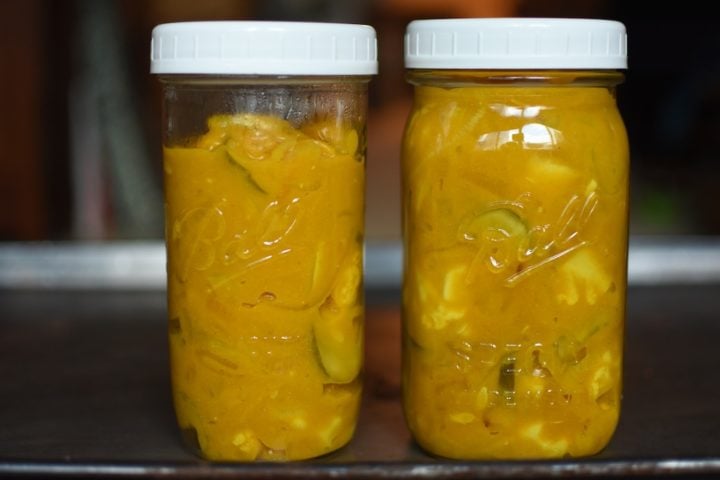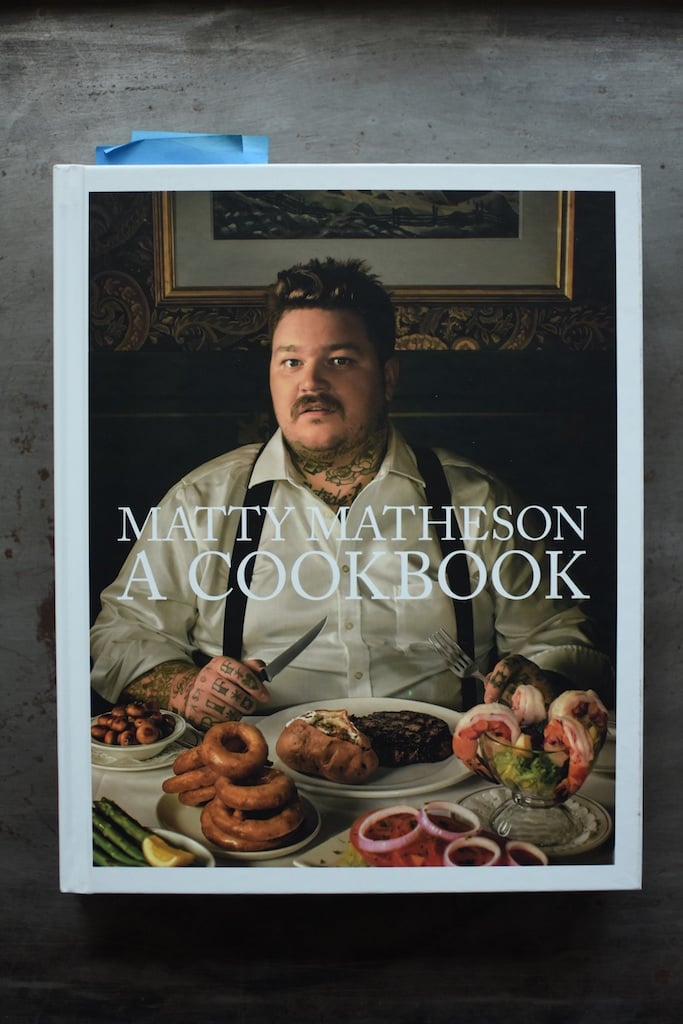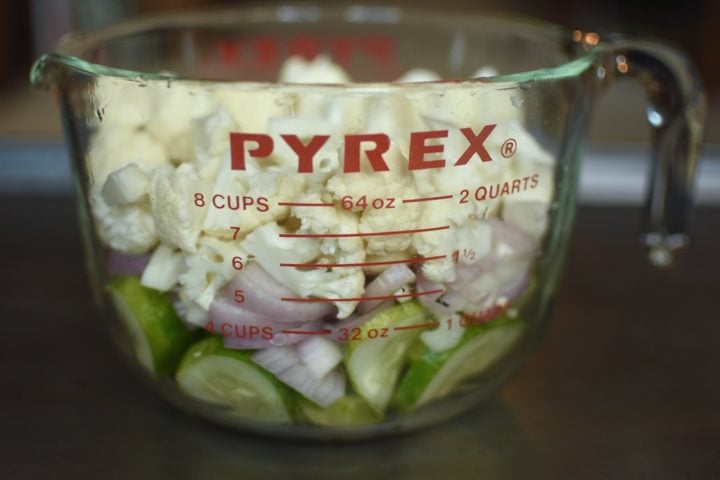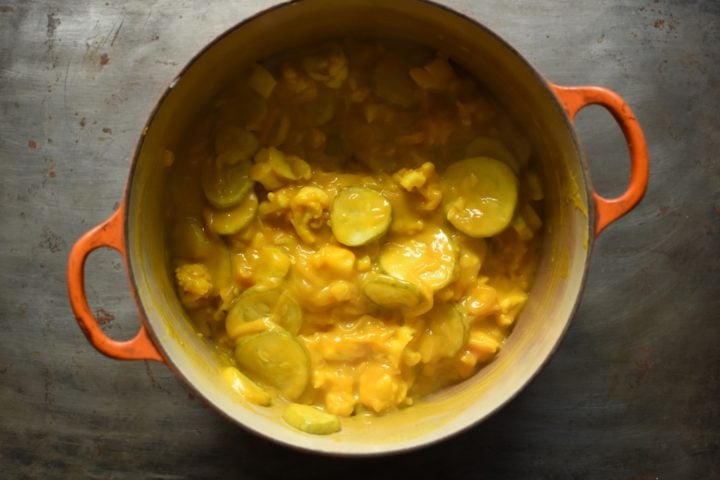Flavored with dry mustard and turmeric, and featuring a thickened brine, these slightly sweet and very sharp mustard pickles are the condiment you didn’t know you were looking for!

Until a copy of Matty Matheson: A Cookbook landed in my mailbox, mustard pickles were not really on my radar. I’d heard people reference them before, but they’d never registered any interest or curiosity on my part. Then, as I flipped through this book (a really gorgeous, personal, interesting volume), Matty’s recipe for mustard pickles caught my eye.
They seem like a fairly standard mixed pickle at first. Onions, cauliflower, cucumber, sugar, and vinegar. But then, I read down further, I spotted cornstarch. A thickener? In a pickle? I did a little reading and discovered that this is a really traditional pickle in parts of Canada and it’s often used in places where one might use ketchup.
I decided I had to try a batch. Now, because of that cornstarch, I knew I’d have to make them as a fridge pickle rather than a preserved one (unmodified cornstarch isn’t heat stable and because it increases the density, it throws everything we know about processing times for pickles into question).
I have reprinted the recipe below exactly as it is written in the book, but I advise that if you make this recipe, you follow my lead and consider this a fridge pickle. Matty’s instructions tell you to use an open kettle method (fill jars, cap, and let the residual heat create the seal), which isn’t thought to be safe by current safety guidelines.
I chopped cucumbers, cauliflower, and shallots (fresh pearl onions were not to be found), and combined them with the sugar and vinegar. I added the mustard powder, turmeric, and salt and brought it to a simmer for 15 minutes to soften. While it cooked, I combined 1/2 cup cornstarch with a couple tablespoons of water.
When the veg was sufficiently softened, I turned off the heat and whisked in the cornstarch slurry. I believe this is a spot where my electric stove led me a little astray. Because it takes a while to cool down, the veg was still quite hot and so the cornstarch thickened a heck of a lot. My mustard pickles ended up being a little pudding-y. I don’t believe that’s the desired texture.
Still, the flavor is good and I have every confidence that we’ll manage to eat through these pickles, gloppy though they might be.
Disclosure: I was given a review copy of this book as part of my participation in the Abrams Dinner Party. No additional payment was received and all thoughts and opinions expressed are entirely my own.

Mustard Pickles from Matty Matheson: A Cookbook
Ingredients
- 2 cups 300 g pearl onions, sliced 1/4 inch (6 mm) thick
- 2 cups 200 g cauliflower, cut in 1/4 inch (6 mm) pieces
- 2 ups 300 g small cucumbers, seeded and sliced 1/4 inch (6 mm) thick
- 1 cup 240 ml white vinegar
- 1/2 cup 100g granulated sugar
- 2 tablespoons dry mustard
- 1 tablespoon turmeric
- 1 tablespoon kosher salt
- 1/2 cup 65 g cornstarch
Instructions
- In a Large pot, place the onions, cauliflower, and cucumbers. Add the vinegar, sugar, dry mustard, turmeric, and salt. Simmer gently until tender, about 15 minutes.
- Turn off the heat. In a small bowl, combine the cornstarch with about 2 tablespoons of water to make a slurry, then whisk the slurry into the vinegar mixture.
- While the mixture is hot, pour it into the Mason jars, cap them, and listen for the "doink" when the cap is pulled in by the cooling of the pickles.
- After about 15 minutes, test the tops with a gentle push to make sure they're sucked in. Don't worry: For any that aren't, you can refrigerate or you can reheat and re-cap.
- Store your pickles in a cool, dry, dark place. [FIJ note: Please do refrigerate these jars, none of this is proper canning procedure.]





Thank you for expressing your concerns about the canning method. I’m surprised that Matty’s publisher allowed this to stand without any caution or qualification. I have a similar recipe from a friend, which is thickened with wheat flour, causing me no end of anxiety even though I process it in a boiling water bath for at least 15 minutes (I still make and enjoy it, as it’s very tasty and nostalgic, if potentially life threatening). My friend’s family would keep a big batch in a crock in the cellar all winter. I think many of these old recipes relied on storage in a reliably cool place, which most modern homes lack, other than of course the refrigerator. They were also mostly consumed in winter. Can I mention my friend’s family story of finding the missing pet hamster in the bottom of the crock one spring. They all survived. Maybe it’s the mustard powder.
Vinegar and mustard powder go a long way. How creepy about the pet hamster though!
Can arrowroot or tapioca be used instead of cornstarch?
I’m honestly not sure how well those thickeners would work here. But given that this isn’t a canned pickle, you could certainly try it.
Hello, I’m from halifax! Having mustard pickles was a staple during roast dinners in my home growing up, sitting on every table setting right between the beets and the gravy. My personal favourite is the flavour of mustard, cranberries, turkey, and a little mashed potato… however, i can see the mustard flavour lending more conventionally to beef and pork for many palates. That all said, no worries about the pudding texture. In my opinion, the thicker the better. A little constitution holds up well when you have half a dozen east coast preserves to contend with on a sunday plate. I made these last year from Matty’s book, as well. It’s great. I love your blog. I just bought a canner last year and enjoy having this resource!
This is the first recipe from this website that has gone awry. Everything else I’ve tried has been absolutely delicious. I agree with Danielle, way too much cornstarch. I noticed other websites tweaked this recipe. Doubled the ingredients while halving the cornstarch/flour.
Jane, you may have noticed that this wasn’t a recipe I developed. I was sharing my experience with a recipe from a cookbook.
How much clear jel would I use since it is recommended as a cooked thickening agent for canning?
I might try just 2-3 tablespoons and see if you like the finished consistency.
Marisa, I also apologize when I said ‘he’ I mean she. So sorry. Ugh. I quit. Lol. Can’t see darn it. Be nice to know if that was WHT you or Matty meant with the cornstarch. Be great to hear from you 🙂 here tho. Never use that email.
Danielle, I reprinted the recipe as it was written in the cookbook.
No way use a half a cup of cornstarch.. holy hell…that has to be a typo (there were several) I’d check another recipe. Flour and not much. You read what happened to his pickled “pudding” as he describes it..so….jeesh. thumbs down for sure. Mustard pickles are very good and very important to so many people all around the world. Don’t trust it as is. May e a clarification will be made. Look further but def make delicious and special mustard pickled everything. Yum! Great on burgers, tacos, wraps, salads and more. Corned beef was a brilliant idea and even baked ham. Best to you all.
Born in Chatham, New Brunswick….my mom pickled a lot. She made chow chow and pickled beets with just vinegar. Mustard pickles was made by an aunt. They all had their thing and I loved the mustard pickles. It was fun be cause of the (trees) cauliflower. We ever ate it unless it came in the MPs. Making this and smelling home….bringing back memories.
I’m so happy to hear it!
I just have to chime in on this one, being from East Coast Canada originally. I smiled at your reference to it’s popularity there. Yes, mustard pickles are a family favourite and I’ve even converted my partner, from Central Canada. Some versions use green beans rather than cukes, and I’ve never tried one with cauliflower. I use my Great Aunt’s recipe that is strictly chunky spears of cucumber, and it uses flour as a thickener.
I love mustard pickles, Nana’s recipe uses flour and we water bath them. I’ve had jars last a few years, but they usually get eaten long before that!
A few years back Smucker announced they were phasing out two brands that made mustard pickles that were popular in Newfoundland.
The announcement caused much consternation.
https://www.atlasobscura.com/articles/the-mustard-pickle-tragedy-unfolding-in-newfoundland
This is very close to what I grew up with in Southwest NS. There was only one type of pickle – mustard! Although my family doesn’t put mustard, just turmeric. The sauce and onions are the best part. Delicious with corned beef!
Interesting, Thanks!
I seem to remember a “mustard” pickle my grandmother made when I was a child. It did not have a thickened juice, but she did cook it down some before adding the veggies. I would eat almost any kind of pickles she “put up” and these were sweeter, almost like a bread and butter style. I also remember as she cooked down the brine it could make your eyes water and your nose run! I had forgotten about these pickles till now.. I think I will try these and leave out the cornstarch, just simmer the brine like Nanny did and then, as you suggested, use these as refrigerator piks. Thanks for jogging my childhood memory and making my mouth water. Tex Gal
Interesting about the cornstarch and your comment that this means it is not a shelf stable preserve that can be easily water bathed canned. My recipe uses flour as a thickner, has always processed well and stays fine on the shelf for 1-2 years. Also, since this is your first time, mustard pickles should be thick and spoonable like a jam not thin like a relish…at least where I am from, Nova Scotia. Are you familiar with a British piccalilli?
The issue with regular cornstarch is that it just doesn’t hold its thickness over time. It does look like the National Center for Home Food Preservation does approve the use of flour for thickening, so I imagine that a mustard pickle that used it and had a similar acidity to this one would be okay to can.
Half a cup of cornstarch seems like an awful lot! I also have an electric stove, maybe I’ll try it with half the cornstarch.